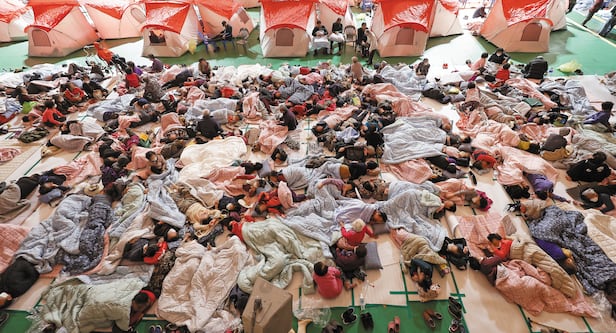
Wildfires that erupted across South Korea on Mar. 21 have rapidly spread nationwide, fueled by dry winds and igniting multiple blazes simultaneously. One major fire that broke out in Uiseong, Gyeongsangbuk-do, on Mar. 22 moved east through Andong, Cheongsong, and Yeongyang before reaching the eastern coastal city of Yeongdeok by Mar. 25. In just three days, the flames traveled approximately 70 kilometers.
Another blaze that began in Sancheong, Gyeongsangnam-do, on Mar. 21 advanced into Jirisan National Park by Mar. 26, pushing toward its highest point, Cheonwangbong Peak. A separate wildfire that started in Ulju, Ulsan, the same afternoon spread southward, threatening the city of Busan.
According to the Korea Forest Service and other agencies, the wildfires have scorched an estimated 65,000 hectares, likely marking the worst wildfire disaster in South Korea’s history. The area burned is roughly equivalent to 91,000 soccer fields. Previously, the largest recorded wildfire occurred in 2000, when 23,794 hectares were burned across Goseong, Gangneung, and Samcheok in Gangwon Province.
“The fire has spread over such an extensive area that assessing the full scale of the damage is taking time,” said an official from the Korea Forest Service.
Between Mar. 25 and 26, the bodies of 21 residents were discovered in the Uiseong area. The confirmed fatalities include eight in Yeongdeok, six in Yeongyang, four in Andong, and three in Cheongsong. In Cheongsong, an 86-year-old woman was found dead in her home, unable to evacuate. In Yeongdeok, a vehicle carrying four nursing home residents and two staff members exploded in the flames, killing three of the elderly passengers. In Yeongyang, a family of three died when their vehicle overturned during a rushed evacuation.
“Most of the deceased were elderly and likely unable to read emergency alerts or evacuate in time,” a fire department official said.
A firefighting helicopter also crashed while conducting suppression efforts, killing the pilot. The incident occurred at 12:51 p.m. on Mar. 26 in Sinpyeong-myeon, Uiseong County. The aircraft reportedly became entangled in power lines while dropping water. The pilot, identified only by the surname Park, was 73.
A total of 118 helicopters have been deployed across wildfire sites nationwide. This marks the first confirmed helicopter crash since firefighting operations began.
Including four firefighters who died on Mar. 22 after being trapped by flames in Sancheong, the total death toll has now reached 26. Authorities warned the number may rise.
More than 28,000 people have been displaced. In Cheongsong alone, nearly half of the county’s population—around 10,000 of 23,000 residents—were forced to evacuate to local community centers and gymnasiums.
The wildfires have also disrupted essential utilities. Parts of Gyeongsangbuk-do experienced water supply outages, while some areas of Gyeongsangnam-do, including Sancheong, reported power failures.
Several cultural heritage sites were threatened by the flames. On Mar. 25, weakened winds helped spare Hahoe Folk Village and Byeongsan Seowon Confucian Academy in Andong, but flare-ups the following day prompted renewed emergency measures. By the night of Mar. 26, the fires had come within two kilometers of the heritage sites. Authorities deployed two helicopters to create a defensive perimeter. Firefighters used 30 hydrants and 19 fire trucks to drench thatched roofs and surrounding areas with water. Andong officials also issued emergency alerts urging residents of Hahoe Village to evacuate to nearby communities.
In Cheongsong, monks at Daejeonsa Temple cut down surrounding trees to help block the encroaching flames.
Meanwhile, the Ministry of Justice relocated approximately 800 inmates from Andong Correctional Institution to other facilities as the fires drew close.



